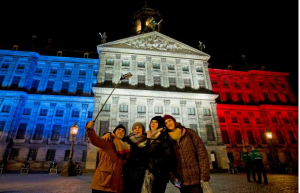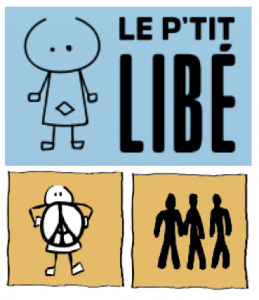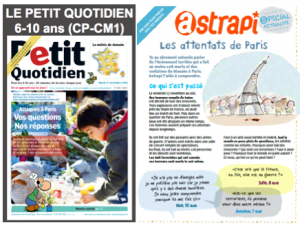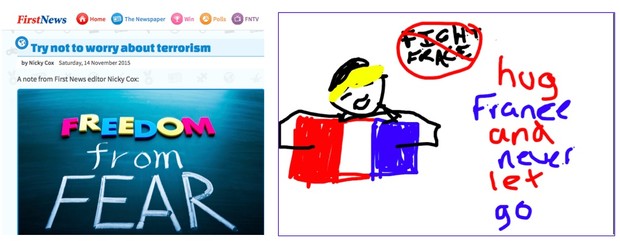SOME LINKS AND DOWNLOADS ARE AT THE BOTTOM OF THE PAGE
For French youth daily editor François Dufour, the task was all too familiar after the murderous attacks in Paris on November 13 that left hundreds of people dead or injured.
 New York Times contributer Pamela Druckerman interviewed Dufour and children as they planned what questions to answer in the first editions after the attack.He felt the editorial team of his dailies and weeklies at Play Bac Presse needed to do the same as they did 11 months ago after in the wake of the killings of Charlie Hebdo journalists and others: help parents, teachers and children understand and talk about what happened.
New York Times contributer Pamela Druckerman interviewed Dufour and children as they planned what questions to answer in the first editions after the attack.He felt the editorial team of his dailies and weeklies at Play Bac Presse needed to do the same as they did 11 months ago after in the wake of the killings of Charlie Hebdo journalists and others: help parents, teachers and children understand and talk about what happened.
"The questions are the same," Dufour said. (Click HERE to see a New York Times commentary and video report about Play Bac's preparation of the post-attack editions.)
For Lotte Stegeman, editor of Dutch weeklies for teenagers (7Days) and for children (Kidsweek), the situation was different. "This was not an attack on journalists like Charlie Hebdo, which makes it all the more threatening to, well, everyone – more like 9/11," she said.
"One of our journalists took a train to Paris yesterday and interviewed a lot of kids and teens about how they feel after the attacks. That will be a big  The Kidsweek site showed how other countries displayed support for the people of Paris.item in both newspapers. Apart from that, we’ll run an interview with an expert that will try to answer the question ‘Will this hit Holland too’?’ Over 50 kids asked us this question…"
The Kidsweek site showed how other countries displayed support for the people of Paris.item in both newspapers. Apart from that, we’ll run an interview with an expert that will try to answer the question ‘Will this hit Holland too’?’ Over 50 kids asked us this question…"
The statistical odds of that threat prompted Nicky Cox, editor of First News in London, to describe on the youth edition's home page exactly what the chances were that any individual in Paris had to have been killed in such an attack, roughly 1 in 18,000 (and 1 in seven billion worldwide).
Russ Kahn, editor of the News-o-Matic digital youth news service, struggled with the decision to cover the story: "There's not much silver lining in it, I'll admit, but in the end we knew we had to.
 Click on the link below to download the Student Daily edition of United Daily News (Taiwan, in Mandarin) "Too many kids would be coming to us with questions and hoping we could provide some sense of understanding. We hope we could provide kids with some measure of comfort; we also sent out a list of tips for parents to try to help them talk to their children about what happened."
Click on the link below to download the Student Daily edition of United Daily News (Taiwan, in Mandarin) "Too many kids would be coming to us with questions and hoping we could provide some sense of understanding. We hope we could provide kids with some measure of comfort; we also sent out a list of tips for parents to try to help them talk to their children about what happened."
These types of events are not unfamiliar territory. "We covered Newtown, the Boston Marathon bombing, and the downing of the airliner over Ukraine. Whether we like it or not, children are hearing about these stories from other avenues -- a TV on in a diner, the front pages blaring at the bus stop, or even a dialogue at the playground"
"To ignore these stories would be a disservice to our young readers," he continued. "They look to us to make sense of tragedies. There frankly isn't anywhere else in America for them to turn that is safe and appropriate for their age. With the  Liberation's new children's edition offered answers to these questions online: Who? Why? What will change for me? What next?help of our on-staff child psychologist, we aim to ease their anxieties by trusting that they can handle the information -- rather than letting them hear about it secondhand, where the fear can really spread."
Liberation's new children's edition offered answers to these questions online: Who? Why? What will change for me? What next?help of our on-staff child psychologist, we aim to ease their anxieties by trusting that they can handle the information -- rather than letting them hear about it secondhand, where the fear can really spread."
At Norway's Aftenposten Junior, editor Guri Leyell Skedsmo also plans to consult an expert on how to tell the larger story to children. The team first published a "light version" online that addressed how to talk with children about the basic information and are preparing a big article for the next print edition about IS, terror in general, the fear, etc.
"We have covered frightening news before, of course. But this one is tough," she explained. "We’ll have a meeting with a well-known Norwegian professor and expert on children and news tomorrow, advising us how to do this [fuller coverage] in the very best way."
In Taiwan's United Daily News a father describes how he talked to his children about the attacks (full edition -- in Mandarin -- can be downloaded below).
Journal des Enfants in France also took a mixed approach of providing some background immediately online, including an explanation of vocabulary, with a more complete treatment planned later in print. "The traffic was exceptional, even more so than after the Charlie Hebdo attacks," said journalist Edith Alberts, with more than 18 000 views very quickly for the main story.
France's Bayard Group will be expanding its efforts to English speakers living in the country. Already, Astrapi, for children 7 to 11, published a special leaflet over the weekend to help children understand and discuss the events with their parents. A free and downloadable version has been widely shared via social media with the New York Times picking up the story. The company plans an English version of the guide "as soon as possible" and will do more for teenagers very quickly, according to Corinne Vorms, marketing and communications editor. Details will be at http://www.bayard-jeunesse.com/
For Jonas Stenbæk Christoffersen, editor of the weekly Kids' News in Denmark, it is crucial to link quickly back to normal activity. "We will make a front page with the attack as the dominant story and change the logo background to the tricolore," he explained, "But we will also make small teasers for other stories on the front page this time. Also to show that life goes on no matter how much cruelty goes on in the world."
MORE LINKS AND DOWNLOADS
ADVICE ABOUT HOW TO TALK WITH CHILDREN
ABOUT HORRIFIC NEWS
(In English unless otherwise noted)
> From Play Bac editor François Dufour
> From News-o-matic on-staff child psychologist Dr. Phyllis Ohr
> An Aftenposten interview with researcher Jon-Håkon Schultz (in Norwegian)
SOME COVERAGE
FRANCE: Journal des Enfants (in French)
FRANCE: Le P'tit Libe (in French)
USA: News-o-Matic (in English) coverage and examples of the drawings children sent
UNITED KINGDOM: Statistical explanation The Fear Factor and latest First News coverage (in English)
RELATED: Paris attacks: Lessons learned from Charlie Hebdo (WAN-IFRA BLOG)
RELATED: OVERVIEW of youth edition coverage of the January 2015 "Charlie Hebdo" attacks in Paris
 Le Petit Quotidien and a two-page explanation from Astrapi were both available free online. You can download the English version of the Astrapi guide below.LINKS TO DOWNLOADS
Le Petit Quotidien and a two-page explanation from Astrapi were both available free online. You can download the English version of the Astrapi guide below.LINKS TO DOWNLOADS
FRANCE: Astrapi guide for 7- t0 11-year-olds and their parents (in French).
FRANCE: Play Bac special editons (in French) about the attack for ages 6 to 10 (Mon Petit Quotidien), ages 10-14 (My Quotidien) and for ages 14-17 (l'Actu) all at www.playbacpresse.fr



